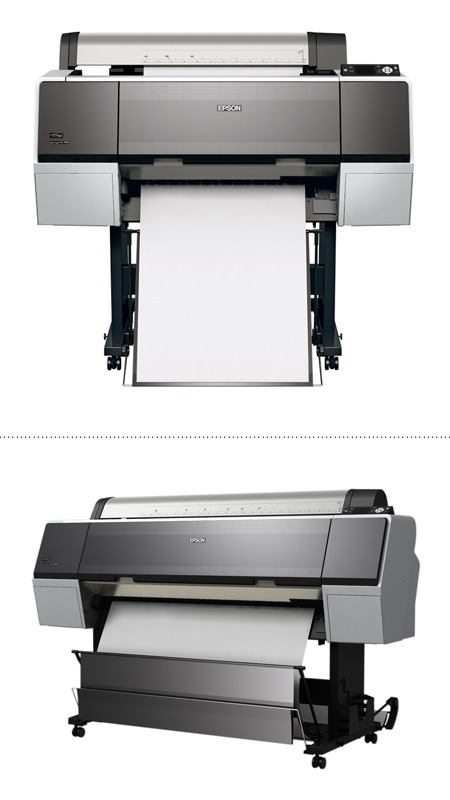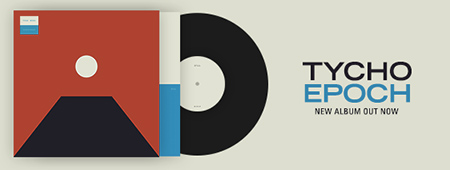Epson Large Format Printers

I got an Epson R1800 a few years back and was always happy with it; the output was incredible and it was rather inexpensive considering. Sadly, it has clogged heads now. I fed it third party ink and then hit the road for a few months. When I returned almost all the colors were jammed up and despite numerous attempts at cleaning with various methods, it’s still not working. Fortuneately, Alex has one and has been printing off my proofs in the meantime while I try to decide on a new printer.
I’ve always kicked myself for not having gone for a larger format printer when I bought the R1800; the 13″ width was very limiting and it just wasn’t economical with those tiny, expensive ink tanks. So this time around I am looking to move up to the large format models, either 26″ or 44″. I have had to outsource a lot of my large format stuff in the past and by now, I probably could have bought the printer with what I’ve spent paying the print shop for jobs. So I think I’ve narrowed the search down to the two new Epson models, the 7900 (24″) and the 9900 (44″). They both have all the same features, they only differ in maximum paper width and price. I posed the question of which one to go with on Twitter today and got some good responses. The one that stuck with me though was from @jheftman: “Buy it nice or buy it twice.” Indeed, I’ve been through that already with the R1800. But I am glad I learned my lessons with the R1800, they could have been much more expensive with one of the large models.
As for the alternatives, I did talk to my friend Erik Natzke about his setup. He’s running an HP 44″ and had nothing but good things to say about it. I have heard a lot of opinions on both platforms and it’s a tough call. In the end I might go with Epson just because that’s what I know and it was a pretty steep learning curve with a lot of trial and error to get predictable color output from the R1800, I wouldn’t want to go through that again with another brand.
So I thought I’d pose the same questions to you: What have your experiences been with large format printers? Any reason that Epson is superior at the point to HP, or vice versa? Sound off in the comments, any info you might have either way would be greatly appreciated.

19 Comments Leave A Comment
marc says:
April 28, 2009 at 1:28 amHow do the larger format printers compare with ink drop size vs the r1800’s? I remember back in art school with the larger format epson printers you couldn’t get type smaller then 9pt to print right (we designer love out small type). Great question though. Personally I’d do the 24″ but that has more to do with limited flour space and I’ve yet to print anything over 24″.
I’ve been lucky with my R1800. It’s still kicking out great prints. I think mine is the last r1800 standing though. Everyone I know that has/ had one it clogs, breaks, or just doesn’t work. What I do love is that i can shove just about any paper size through it, and I think shoving a full parent sheet of BFK through a 44″ would be sweet.
AntonTV says:
April 28, 2009 at 4:26 amA few years back I was looking for a large format printer for small run POS. I visited a supplier who sold both HP and Epson. He told me that for production runs the HP was more cost effective but for proofing you had to go with Epson. We went with the HP because we had quite a lot to print and it was great for running things off quickly. Where I work now we have an Epson because we need to proof before sending to print and it seems to be spot on. That’s all I can tell you.
marshall says:
April 28, 2009 at 4:40 amthe museum i used to design for has a 44″ HP printer. thing was awesome, we printed on all kinds of materials and everything always looked great.
http://h10010.www1.hp.com/wwpc/us/en/sm/WF25a/18972-18972-3328061-12600-3328079-3204963.html
thats the one we used… i dunno what you consider expensive but thats pretty pricey. though they do have the 22 inc model.
Richard Kline says:
April 28, 2009 at 6:17 amI bought an early Epson 9000 large format printer. After 3 years the heads clogged and I bought new ones from National Parts Service in Chester NY. I replaced them myself and it worked as good as new. It took about a half a day to take the system apart, put in the new heads and put it all back together.
Now I have a new Epson 9800 and love it.
Zach says:
April 28, 2009 at 8:11 amThe studio at my advertising agency runs an HP 44″ and I’m constantly running into trouble getting it to separate out blacks/grays (might not be a huge issue for your prints, but as I primarily work on Johnnie Walker Black Label it’s become a bit of an annoyance).
I’ve worked with Epson’s in the past, and really have no complaints. Also, instead of just dropping 6k on a printer like that it might make sense to lease it. I know a lot of places, B&H for example, let you lease the high end Epsons. Then you can just renew in a year or two with a newer model.
R Scott Koerper says:
April 28, 2009 at 11:00 amI’ve been using a 7880 for photographic prints, and when calibrated correctly with the right paper, it puts out amazing results.
As far as the 24 vs 44 debate goes, are prices on large format prints enough to justify the difference in printer and roll paper price? Unless I was going to be printing 44 inch wide prints on the regular, the savings on a 24 would make it easier to replace the printer in the future as you’re doing now.
Oh, and next time you buy photo paper, try Museo Silver Rag. Literally amazing blacks and true tones on this paper.
Cheers.
Swift says:
April 28, 2009 at 11:12 amWe are running both the 7800 & 9800 at work & abuse them on a daily basis, proofing and printing a huge amount of work. Both are solid reliable machines & consistently produce great prints.
Peter says:
April 28, 2009 at 11:24 amMy two cents is that it’s reasonably easy to get replacement heads (and any other parts) for large format printers and a service manual to take it apart. I found an older HP large format printer in a dumpster and took it apart, cleaned it, replaced the heads (they snap on) and it was good to go.
Scott says:
April 28, 2009 at 12:36 pmthanks everyone for the info, very helpful.
@zach
I never even thought of that, I will look into it for sure. It would make a lot more sense in a lot of respects.
as for the head replacement, I plan on getting those ordered, just need to get around to it. I did read an interesting article about how to dismantle and unclog r1800 heads so might try that first.
scott lowe says:
April 28, 2009 at 8:45 pmThe printers we have at my college are HP 48″ ( thought but they might be 44 since thats what everyone seems to be talking about) also a company i worked for had an identical 48″ (i thought) model. loved it. the wider format allows you to print much more quickly since you only have to print the short length. the quality seemed to be ok but we are architects not artists.
You will want the versatility of the wider printer I believe. its the difference between having an 8.5×11 scanner and 11×17 scanner. So much time saved!
jarred says:
April 28, 2009 at 8:59 pmwe have an Epson 9880 44” with the Niagara inking system at University of Tennessee, Knoxville Design Center. We all dig it. It’s easy to use and quite reliable.
When we first got it things came out a bit dark, but it was nothing a bit of calibration couldn’t fix. I’ve even put some arches 88 through it and got some pretty decent results.
-jarred
Scott says:
April 28, 2009 at 9:45 pm@scott lowe
good call, didn’t even think about the fact that it can print faster if you feed smaller docs to it in landscape, thanks for the tip.
@jarred-
yeah, I had the same issues with the R1800, but was just a matter of calibration and also the proper workflow when outputting from PS, all sorts of counter intuitive settings like in order to get the right color you have to “turn color management off”….weird, but it works.
A-Ron says:
April 29, 2009 at 8:25 amA lot of the difference between Epson and HP printers lies in the print head HP uses a thermal print head whereas Epson uses a piezo print head. I personally prefer the piezo print heads over the thermal print heads because of there superior output, but thermal print heads allow you to produce graphics at a greater rate, but they wear out and need to be replaced more frequently. I work with some older model 60″ HP printers and we go through a set of print heads about ever month, not that thats a problem, thermal print heads are designed to be replaced easily. I’d still go with the Epson because of the piezo print head.
jheftmann says:
April 29, 2009 at 1:50 pmnice product photo (esp. on that first shot), Epson.
Ray says:
April 29, 2009 at 5:52 pmWe use an HP Designjet T1100 at work and i must say it is a piece of shit.
The colors are inconsistent. You will notice that if your printing a flat color on just about any paper, there will be color modulations at the edges of that particular color field. Its not something thats completely noticeable, but I notice and it secretly drives me nuts.
Also the Print Drivers arent as good, and sometimes youll find yourself inventing new ways to tell the Printer to print shit. It can get ridiculous.
Another thing with the colors is they look dull, like you left your print out in the sun for a couple of days. We’re printing on some high quality papers too, so its not that.
Chris says:
April 30, 2009 at 7:01 amI still have an R1800 and am wondering you would like to share you color correction solutions. I’ve struggled with this for a long time and still can’t get what I’m looking for.
Scott says:
April 30, 2009 at 1:57 pmchris-
we’ll try to outline it in a future color calibration post we’re working on..
Terry Sutton says:
May 1, 2009 at 12:08 pm7800. Incredible results. Used once a month or less with no maintenance or clogs. B&W is mindblowing.
spence says:
May 2, 2009 at 9:11 amScott, i’ve owned the Epson 9600, 7600, 4400 and the 9800 as well as the ZT2100 series from HP. All are awesome printers. Prefer the look mids and darks on the Epsons. HP’s colors felt too contrasty & cheerful for me. S